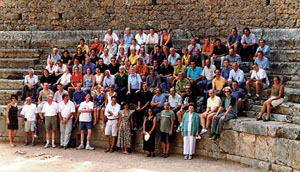
Although CERN’s LEP electron-positron collider finished operating in November 2000, analysis of the enormous amount of data it produced will continue for some time. On 19-25 September the collaboration of the DELPHI experiment held a meeting in Delphi, on the slopes of Mount Parnassus in Greece, to discuss recent results.
The name DELPHI is an acronym (DEtector with Lepton, Photon and Hadron Identification), but the collaboration includes several groups from Greece. When the name was chosen, in 1982, these groups immediately invited the collaboration to hold a meeting in Delphi. This took place in June 1983, at the start of DELPHI construction.
The return to Delphi in 2001 was therefore something of a sentimental journey. However, only eight people participated in both meetings. An impressive number of young people now working on DELPHI analysis were only in high school at the start of the experiment.
The meeting was organized by DELPHI’s three Greek groups (National Technical University, University of Athens and Demokritos) under the chairmanship of Theodora Papadopoulou of NTUA.

The opening session was addressed by NTUA rector Themistoclis Xanthopoulos. Although himself an engineer, Xanthopoulos stressed the need for supporting fundamental research and he expressed concern that, with the increasing emphasis on the market economy in university education, funding for basic research would come under great pressure.
Talks concentrated on the progress towards the finalization of the precision measurements of the parameters of the W and Z bosons; their couplings; testing the Standard Model at the highest energies yet obtainable; and the searches for new particles.
The searches for the particles predicted by supersymmetry seem to have drawn a clear blank throughout the entire LEP2 energy range, already ruling out most versions of the model. On the other hand, the search for the elusive Higgs boson – the origin of electroweak symmetry breaking and the boson responsible for particle masses – ended on an ambiguous note, with some suggestion that LEP had been on the verge of a major discovery (Season of Higgs and melodrama). A session called “Elementary particle physics – theory and experiment” was attended by 60 physics teachers from local high schools.
The opinion of all of the participants was that the meeting was a worthy successor to the 1983 meeting. It was remarkable to witness how LEP and DELPHI, together with all of the other experiments, had surpassed the design expectations formulated some 20 years ago.
The meeting highlighted the important contributions being made by Greek high-energy physicists and hopefully will contribute to assuring support for this significant work.





